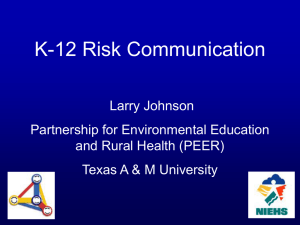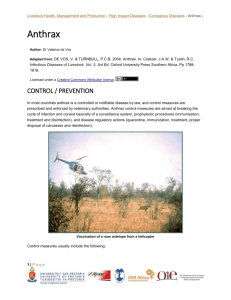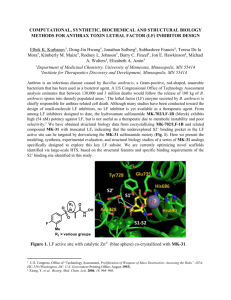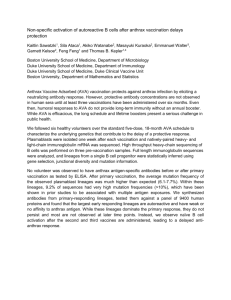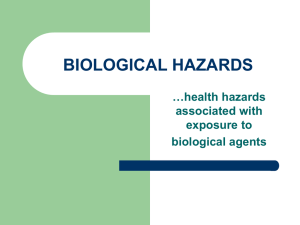anthrax_8_faq
advertisement
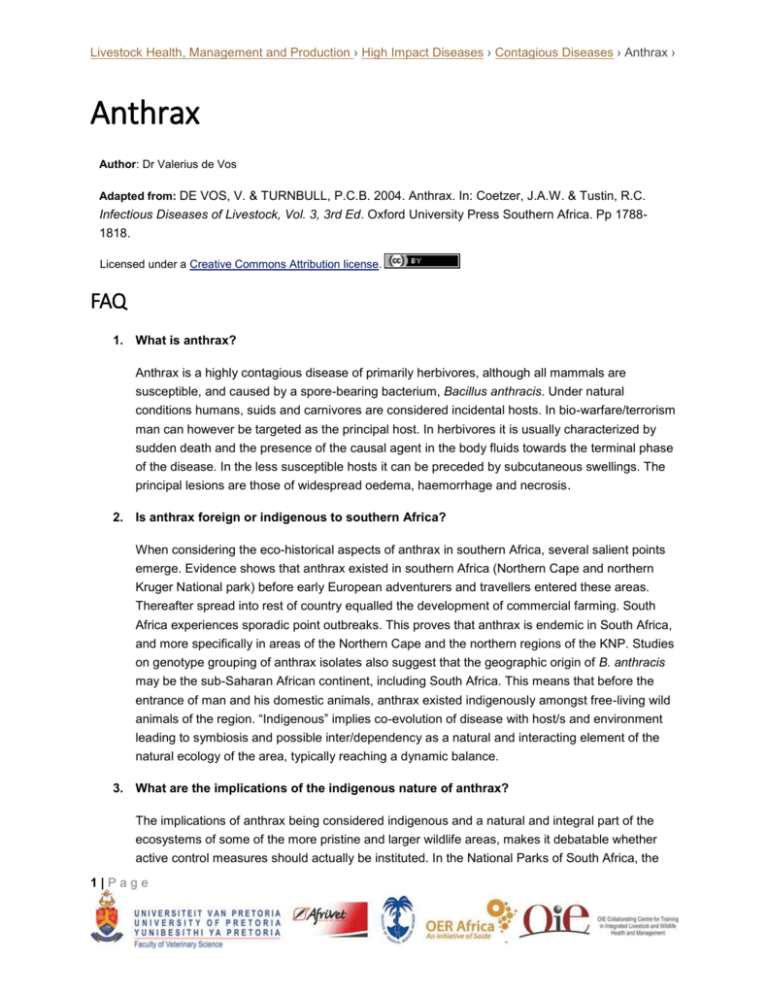
Livestock Health, Management and Production › High Impact Diseases › Contagious Diseases › Anthrax › Anthrax Author: Dr Valerius de Vos Adapted from: DE VOS, V. & TURNBULL, P.C.B. 2004. Anthrax. In: Coetzer, J.A.W. & Tustin, R.C. Infectious Diseases of Livestock, Vol. 3, 3rd Ed. Oxford University Press Southern Africa. Pp 17881818. Licensed under a Creative Commons Attribution license. FAQ 1. What is anthrax? Anthrax is a highly contagious disease of primarily herbivores, although all mammals are susceptible, and caused by a spore-bearing bacterium, Bacillus anthracis. Under natural conditions humans, suids and carnivores are considered incidental hosts. In bio-warfare/terrorism man can however be targeted as the principal host. In herbivores it is usually characterized by sudden death and the presence of the causal agent in the body fluids towards the terminal phase of the disease. In the less susceptible hosts it can be preceded by subcutaneous swellings. The principal lesions are those of widespread oedema, haemorrhage and necrosis . 2. Is anthrax foreign or indigenous to southern Africa? When considering the eco-historical aspects of anthrax in southern Africa, several salient points emerge. Evidence shows that anthrax existed in southern Africa (Northern Cape and northern Kruger National park) before early European adventurers and travellers entered these areas. Thereafter spread into rest of country equalled the development of commercial farming. South Africa experiences sporadic point outbreaks. This proves that anthrax is endemic in South Africa, and more specifically in areas of the Northern Cape and the northern regions of the KNP. Studies on genotype grouping of anthrax isolates also suggest that the geographic origin of B. anthracis may be the sub-Saharan African continent, including South Africa. This means that before the entrance of man and his domestic animals, anthrax existed indigenously amongst free-living wild animals of the region. “Indigenous” implies co-evolution of disease with host/s and environment leading to symbiosis and possible inter/dependency as a natural and interacting element of the natural ecology of the area, typically reaching a dynamic balance. 3. What are the implications of the indigenous nature of anthrax? The implications of anthrax being considered indigenous and a natural and integral part of the ecosystems of some of the more pristine and larger wildlife areas, makes it debatable whether active control measures should actually be instituted. In the National Parks of South Africa, the 1|Page Livestock Health, Management and Production › High Impact Diseases › Contagious Diseases › Anthrax › current policy is to institute active control measures against anthrax only if it affects biodiversity negatively (e.g. by threatening the survival of low density or threatened species), and/or where the actions of humans (such as fencing or the provision of artificial watering points), are providing unnatural impetus to an outbreak. A general rule of thumb for deciding whether or not to implement control measures in wildlife areas is that the bigger and more natural and selfsufficient an area is, the less control measures should be implemented, and vice versa. Anthrax, being endemic and indigenous in certain wildlife areas, can also have implications for export of animals and by-products, such as hunting trophies. 4. Which animals are susceptible to anthrax and does susceptibility vary? Anthrax is a disease primarily of herbivores, although all mammals are susceptible. Anthrax deaths have been recorded in at least 59 mammal species, but the susceptibility of different species to anthrax varies considerably. Discrepancies between susceptibility and prevalence of disease can also be explained in terms of differences in behaviour, such as feeding habits, and routes of infection; i.e. differences in vulnerability. In the Kruger National Park, the browsers have a higher vulnerability to anthrax than the grazers. In phosphorus-deficient areas in South Africa, osteophagia may increase the likelihood of cattle contracting anthrax; sheep do not usually manifest osteophagia under the same circumstances and are less vulnerable. In contrast to herbivores, pigs and carnivores are highly resistant to anthrax and the ingestion of large numbers of B. anthracis in infected meat is generally required to induce infection in them. The feeding behaviour of these animals, however, exposes them to much higher levels of infection than is the case with herbivores, and severe mortalities have been recorded. In captive situations, such as in zoological gardens and on fur farms, outbreaks of anthrax are mostly limited to carnivorous species fed infected meat. Age also affects the susceptibility of animals to anthrax; adults being generally more vulnerable than the young or subadults. Different behaviour patterns and feeding habits may predispose to this phenomenon, although there may also be a specific, but as yet, not understood, physiological basis. No sex differentiation could be found. Humans are regarded as fairly resistant to infection. Normally humans are infected incidentally, almost always acquiring the disease directly or indirectly from infected animals, when handling, or eating meat from, the carcasses of animals that have died of anthrax, or through occupational exposure to animal products contaminated with anthrax spores. 5. What is the recommended vaccination procedure for various species? Vaccination with the Sterne spore vaccine is done annually for all cattle in high-risk areas. This also applies to captive wild animals where possible. The Sterne vaccine is, for all practical purposes, non-pathogenic in most domestic and wild animal species. It however, appears to retain a degree of virulence for certain species such as goats and llamas. In such species, two inoculations one month apart, with the first being one quarter of the standard dose and the second being the full standard dose, are recommended. In horses two standard doses one month apart and a single annual booster thereafter are recommended. In the other species a single 2|Page Livestock Health, Management and Production › High Impact Diseases › Contagious Diseases › Anthrax › inoculation provides effective immunity for about nine months to a year. Effective immunity generally develops within a week of vaccination, although in horses it may take a month or more. Outbreaks of anthrax in livestock are usually brought under control within a week to ten days of vaccination of affected herds. 6. What constitutes a well-designed control action plan in domestic species once an outbreak has taken place? Anthrax control measures are aimed at breaking the cycle of infection and consist basically of a surveillance system, prophylactic procedures (immunization, treatment and disinfection), and disease regulatory actions (quarantine, immunization, treatment, proper disposal of carcasses and disinfection). Control measures usually include the following: Effective surveillance and reporting procedures, providing an early warning system, and delineating high-risk areas. Quarantine procedures, isolating an infected and contaminated area and animals until safe. To prevent excess sporulation of the vegetative growth form of B. anthracis, carcasses should not be opened. For disposal of carcasses, where possible, burial should be discouraged in favour of incineration. Where burial is the only option carcasses should be buried at a depth of two metres after being covered liberally with a mixture of chloride of lime, containing at least 25 per cent of active chlorine, and enclosed in plastic sheeting; the rationale being that chlorine gas develops and sterilizes the carcass. The WHO has published guidelines for the disinfection of B. anthracis-infected material. For the disinfection or decontamination of anthrax-infected/contaminated material and soil, formaldehyde (2%-10%) is generally preferred. In particularly valuable animals exposed to anthrax, treatment with bactericidal antibiotics may be used as a prophylactic measure. Simultaneous vaccination is contraindicated. 7. Taking into account the very effective Sterne spore vaccine, is anthrax still a major problem? Yes, anthrax bacilli can convert into a very resistant spore form. Spores can survive for hundreds of years in carcass rests (especially bone) and calcareous soils. Anthrax spores can also survive in opened and unopened (spore formation already start shortly before death in vivo) carcasses buried for many years (80 years have been documented). During the 1923 anthrax epidemic in the RSA it was estimated that 30 000 to 60 000 animals died. Most of them were buried. The locality of very few was documented. Inadvertently opening these burial pits have caused anthrax outbreaks in the past and will so in future. Because of practical difficulties encountered in vaccinating free-living wild animals, anthrax retains an endemic presence in large free-ranging 3|Page Livestock Health, Management and Production › High Impact Diseases › Contagious Diseases › Anthrax › wildlife areas in several regions of the world. In southern Africa in large wildlife areas such as Etosha, Kruger Park and Northern Cape, anthrax is endemic with cyclic epidemics. Livestock farming are also rapidly being replaced by wildlife in areas of the Eastern Cape, Northern Cape and the northern bushveld of South Africa, exacerbating the anthrax problem. It therefore seems that anthrax is in southern Africa to stay, at least for the foreseeable future. It is expected that sporadic point outbreaks will occur in livestock and sporadic to cyclic epidemics in wildlife areas. 8. How would naturally occurring anthrax differ from a terrorist or warfare event? It is important to clearly distinguish natural and bio-aggression situations. The massive and overwhelming exposure doses that can be created in man-made, deliberate release scenarios cannot be remotely copied by nature. The natural disease is readily controllable. The potentially much more severe epidemic that could result from a biowarfare or bioterrorist act would be a much greater challenge to bring under control. This also explains why there is no conflict between the statements that humans are moderately resistant to anthrax infection and, on the other hand, the choice of anthrax spores by an aggressor. 4|Page

